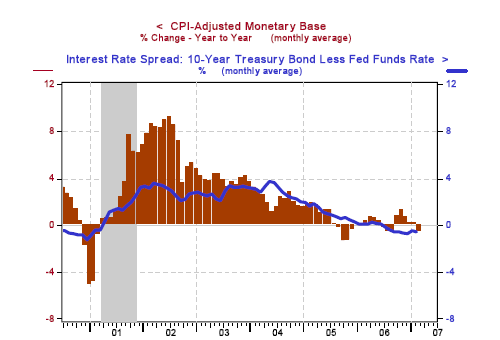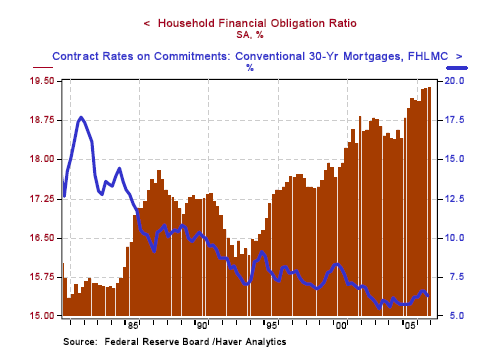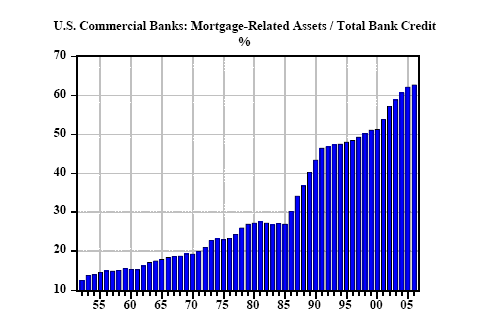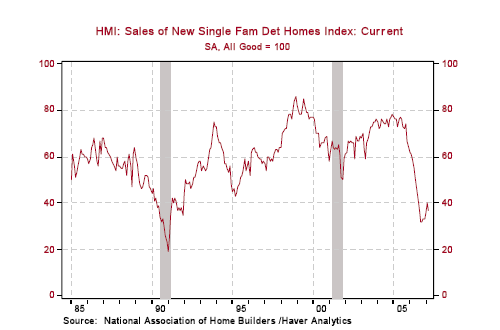US Recession Watch Perhaps, But Not Yet Warning
Economics / US Economy Mar 20, 2007 - 09:20 AM GMTBy: Paul_L_Kasriel
 Every recession commencing with the one in 1970 has been preceded by the combination of a negative spread between the Treasury 10-year yield and the federal funds rate and a year-over-year contraction in the CPI-adjusted monetary base (bank reserves plus currency). When both of these variables are calculated on a quarterly average basis, there have been no false recession alarms. To date, every recession has been preceded by at least two quarters of this combination. This is shown in Chart 1 in which the vertically-shaded areas represent recessionary periods.
Every recession commencing with the one in 1970 has been preceded by the combination of a negative spread between the Treasury 10-year yield and the federal funds rate and a year-over-year contraction in the CPI-adjusted monetary base (bank reserves plus currency). When both of these variables are calculated on a quarterly average basis, there have been no false recession alarms. To date, every recession has been preceded by at least two quarters of this combination. This is shown in Chart 1 in which the vertically-shaded areas represent recessionary periods.
Chart 1

On a monthly average basis, this combination occurred back in July and August of 2006 (see Chart 2). But in September, growth in the real monetary base resumed enough to allow the quarterly average year-over-year change in the real monetary base to be barely (0.1%) positive. With the release of the February 2007 CPI data, this combination has reappeared. The real monetary base in February was down 0.5% year-over-year and the spread was negative by 54 basis points. As things now stand, in order for the first quarter of this year to have a positive year-over-year change in the real monetary base, the March value of the real base would have to be about 0.2% above that of March 2006. With the year-over-year increase in the March CPI likely to be around 2.3%, this would require a year-over-year increase in the March nominal monetary base of 2.5% in order to get a positive year-over-year change in the real monetary base. The fact that this combination exists on a one-month basis suggests that the conditions for a recession to develop exist, but are not yet sufficient to suggest that a recession is imminent. So, I have put up the recession watch flag, not yet the recession warning flag. But stay close to your weather radio.
Chart 2

Real Retail Sales Are Looking Peaked In Q1
Last week we discussed how soft nominal retail sales have been of late. With Friday's release of the February CPI data, we can get a bead on real retail sales. They are looking pretty piqued, too. Deflating nominal retail sales by the CPI for consumer goods (but not services), we find that real retail sales increased by less than 0.1% (not annualized) month-to-month in January and contracted by almost 0.3% in February. The January-February average is running at only 1.9% annual rate above the Q4:2006 average. Even if March real retail sales increase 0.5% month-to-month, that would yield first quarter annualized growth in these sales of only 2.4% -- a far cry from the 10.5% annualized growth of Q4:2006. It must be the weather, huh? It can't be related to the sharp drop in mortgage equity withdrawal, the slowdown in job growth and already record high debt service burdens (see Chart 3) in the face of an onslaught of adjustable rate mortgage resets.
Chart 3

US Banking System Has Record Mortgage Exposure
Chart 4 shows that at the end of 2006, US commercial banks' mortgage-related assets represented 62.7% of their total earning assets - a post-WWII record high. These mortgage-related assets included commercial as well as residential mortgage-related loans and securities. And these assets include mortgages, various kinds of mortgage-backed securities and the securities issued by government sponsored enterprises such as Fannie Mae and Freddie Mac, which themselves are mortgage-related. I have no way of knowing how much the now infamous CDOs represent of the total. Mortgages alone are 45.8% of total earning assets. A couple of weeks ago I was at a monetary policy conference in our nation's capital at which Minneapolis Fed President Stern said that commercial banks had sold off most of their "plain vanilla" loans via securitization, the implication being that the remaining loans on their books were "tutti fruiti" (my words, not his). When I asked President Stern if the remaining tutti fruiti were a lot of exotic mortgage flavors, he seemed to wince, but did not respond.
Chart 4

Toll Brothers and D.H. Horton Evidently Participate in March NAHB Survey
The National Association of Home Builders released the results of their March survey of demand conditions. I am not particularly interested in their 6-month outlook or their perception of lookers. Rather, I want to know how they rate current sales. And after showing incongruous strengthening - not absolute strength, just strengthening - the March index of current sales of single-family homes retreated by three points to a level of 37 (see Chart 5). This is more consistent with what some of the more candid home builders have been saying of late. Last week, a spokesperson for Toll Brothers said that so far the spring sales season was a "bust." A couple of weeks before, the CEO of D.H. Horton said that the new home sales market in 2007 would "xxxx." I can't repeat the word he used to describe the outlook because this is a family financial service institution. Suffice it to say, the Horton CEO was pessimistic. The recent tightening in mortgage underwriting standards across all risk categories, while predictable, will nevertheless put another down leg onto the housing recession. Therefore, look for further declines in the Home Builders index.
Chart 5

By Paul Kasriel
The Northern Trust Company
Economic Research Department - Daily Global Commentary
Paul joined the economic research unit of The Northern Trust Company in 1986 as Vice President and Economist, being named Senior Vice President and Director of Economic Research in 2000. His economic and interest rate forecasts are used both internally and by clients. The accuracy of the Economic Research Department's forecasts has consistently been highly-ranked in the Blue Chip survey of about 50 forecasters over the years. To that point, Paul received the prestigious 2006 Lawrence R. Klein Award for having the most accurate economic forecast among the Blue Chip survey participants for the years 2002 through 2005.
The opinions expressed herein are those of the author and do not necessarily represent the views of The Northern Trust Company. The Northern Trust Company does not warrant the accuracy or completeness of information contained herein, such information is subject to change and is not intended to influence your investment decisions.
© 2005-2022 http://www.MarketOracle.co.uk - The Market Oracle is a FREE Daily Financial Markets Analysis & Forecasting online publication.


